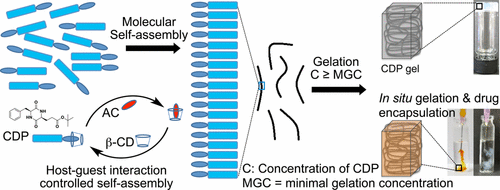当前位置:
X-MOL 学术
›
Biomacromolecules
›
论文详情
Our official English website, www.x-mol.net, welcomes your feedback! (Note: you will need to create a separate account there.)
Cyclic Dipeptide-Based Ambidextrous Supergelators: Minimalistic Rational Design, Structure-Gelation Studies, and In Situ Hydrogelation
Biomacromolecules ( IF 6.2 ) Pub Date : 2017-09-14 00:00:00 , DOI: 10.1021/acs.biomac.7b00924 Shivaprasad Manchineella 1 , N. Arul Murugan 2 , Thimmaiah Govindaraju 1
Biomacromolecules ( IF 6.2 ) Pub Date : 2017-09-14 00:00:00 , DOI: 10.1021/acs.biomac.7b00924 Shivaprasad Manchineella 1 , N. Arul Murugan 2 , Thimmaiah Govindaraju 1
Affiliation

|
Ambidextrous supergelators are developed through structure-gelation screening of rationally designed cyclic dipeptides (CDPs). The organo- and hydrogels of CDPs were thoroughly characterized by their minimal gelation concentration (MGC) for organic and aqueous solvents, thermal stability (Tg), and viscoelastic properties. Intermolecular hydrogen bonding, the major driving force for gelation was evaluated using temperature-dependent nuclear magnetic resonance (NMR) spectroscopy. The contribution of attractive van der Waals interaction of tBoc group in driving CDP gelation was ascertained using β-cyclodextrin (β-CD)-adamantane carboxylic acid (AC)-based host–guest gelation and 1H NMR studies. The self-assembled fibrous network of CDPs in organic and aqueous solvents responsible for the molecular gelation was elucidated using field emission scanning electron microscopy (FESEM) analysis. Among the CDPs studied CDP-2 found to be supergelator with MGC of 0.3 wt % and form in situ hydrogels under simulated physiological conditions. The in situ gelation property was evaluated by the incorporation of curcumin, as a model study to demonstrate the drug delivery application. Furthermore, supergelator CDP-2 was found to exhibit in cellulo cytocompatibility. Moreover, density functional theory (DFT) calculations were carried out to propose the microscopic structure for the self-assembly of CDP compounds and intermolecular N–H···O hydrogen bonding interactions appear to stabilize the fibrous network. The hydrophobic interactions among the tert-butyloxycarbonyl (tBoc) groups and π–π stacking interactions between phenyl rings contribute to the further stabilization of self-assembled 2D fibrous networks of CDPs. Overall, the present study highlights the in situ gelation property of CDP-based supergelators and their potential for biomedical and regenerative medicine applications.
中文翻译:

基于环状二肽的双极性超级凝胶剂:简约的合理设计,结构-交联研究和原位水凝胶化
通过合理设计的环状二肽(CDP)的结构-凝胶筛选,开发出了两栖超级凝胶剂。CDPs的有机凝胶和水凝胶通过其对有机和水性溶剂的最小胶凝浓度(MGC),热稳定性(T g)和粘弹性特性进行了彻底表征。分子间氢键,凝胶化的主要驱动力是使用温度依赖性核磁共振(NMR)光谱法进行评估的。使用基于β-环糊精(β-CD)-金刚烷羧酸(AC)的宿主-客体凝胶法和1确定了tBoc组有吸引力的范德华相互作用在驱动CDP凝胶中的作用1 H NMR研究。使用场发射扫描电子显微镜(FESEM)分析阐明了CDP在有机和水性溶剂中负责分子凝胶化的自组装纤维网络。在所研究的CDP中,CDP-2是具有0.3 wt%的MGC的超级胶凝剂,并在模拟的生理条件下形成原位水凝胶。通过掺入姜黄素评估原位凝胶化特性,作为模型研究来证明药物递送的应用。此外,发现超级胶凝剂CDP-2表现出纤维素细胞相容性。此外,进行了密度泛函理论(DFT)计算,提出了CDP化合物自组装的微观结构,分子间的N–H···O氢键相互作用似乎可以稳定纤维网络。叔丁氧羰基(tBoc)基团和苯环之间的π-π堆积相互作用有助于CDP自组装2D纤维网络的进一步稳定。总体而言,本研究突出了基于CDP的超级胶凝剂的原位胶凝特性及其在生物医学和再生医学应用中的潜力。
更新日期:2017-09-15
中文翻译:

基于环状二肽的双极性超级凝胶剂:简约的合理设计,结构-交联研究和原位水凝胶化
通过合理设计的环状二肽(CDP)的结构-凝胶筛选,开发出了两栖超级凝胶剂。CDPs的有机凝胶和水凝胶通过其对有机和水性溶剂的最小胶凝浓度(MGC),热稳定性(T g)和粘弹性特性进行了彻底表征。分子间氢键,凝胶化的主要驱动力是使用温度依赖性核磁共振(NMR)光谱法进行评估的。使用基于β-环糊精(β-CD)-金刚烷羧酸(AC)的宿主-客体凝胶法和1确定了tBoc组有吸引力的范德华相互作用在驱动CDP凝胶中的作用1 H NMR研究。使用场发射扫描电子显微镜(FESEM)分析阐明了CDP在有机和水性溶剂中负责分子凝胶化的自组装纤维网络。在所研究的CDP中,CDP-2是具有0.3 wt%的MGC的超级胶凝剂,并在模拟的生理条件下形成原位水凝胶。通过掺入姜黄素评估原位凝胶化特性,作为模型研究来证明药物递送的应用。此外,发现超级胶凝剂CDP-2表现出纤维素细胞相容性。此外,进行了密度泛函理论(DFT)计算,提出了CDP化合物自组装的微观结构,分子间的N–H···O氢键相互作用似乎可以稳定纤维网络。叔丁氧羰基(tBoc)基团和苯环之间的π-π堆积相互作用有助于CDP自组装2D纤维网络的进一步稳定。总体而言,本研究突出了基于CDP的超级胶凝剂的原位胶凝特性及其在生物医学和再生医学应用中的潜力。



























 京公网安备 11010802027423号
京公网安备 11010802027423号